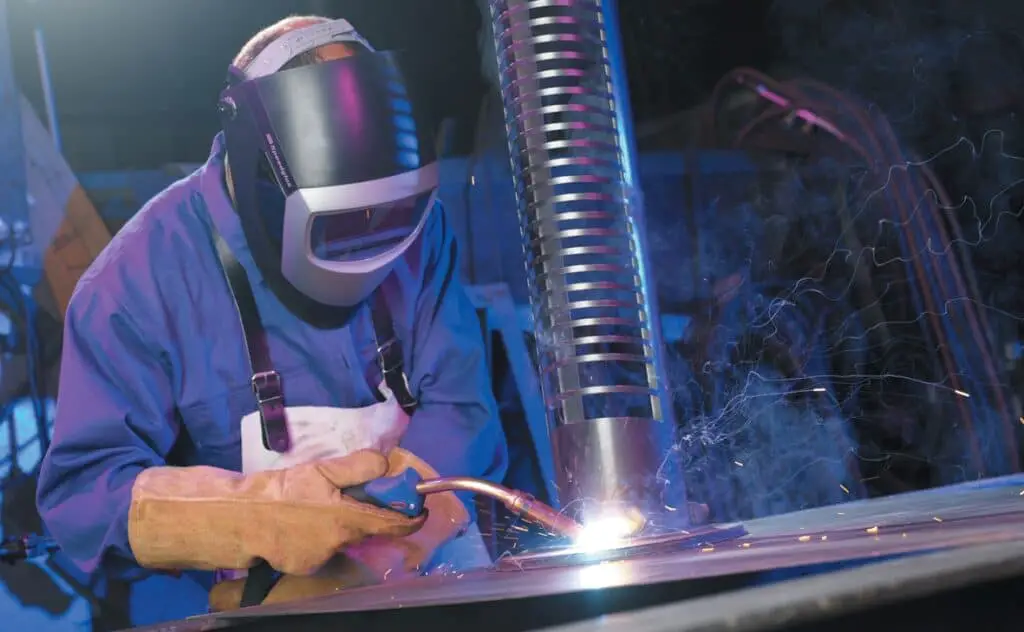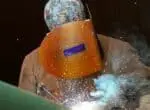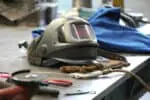Welding helmets are quintessential PPE pieces for the safety of welders at work. There are basically three types that can be found in the market: battery-operated welding helmets, solar welding helmets, and solar-powered welding helmets with batteries.
Out of the three types, it’s the solar-powered welding helmets with batteries that are the best options.
The solar-powered welding helmets naturally charge in the Sun since they have photovoltaic cells. But, at the same time, these helmets also charge while welding. They are equipped with lithium-ion batteries.
UV rays emitted during the welding process carry out the function of charging the helmet much as the sun rays do. So, even if you hadn’t had the chance to keep your helmet under the Sun, it will still offer protection the minute the welding arc is struck.
It’s not one feature that makes solar-powered welding helmets so phenomenal. There are many other features such as their affordability, durability, and ease of use that contribute to their popularity.
In this guide, you’ll be able to explore all the details about solar-powered welding helmets with batteries: how to charge them, the advantages and constraints of wearing them, are they better than battery-operated welding helmets, and much more. Dive in for all the details!
How Does a Welding Helmet Charge?
The solar-powered welding helmets can be charged in two ways.
The first way is to keep the helmet under the Sun. The photovoltaic cells will use solar energy to charge the helmet.
The second way is charging the helmet while welding.
When the welding arc hits the metal and the process begins, alongside the heat, UV rays are also produced. Those UV rays charge the helmet while you’re working.
See also: Do Welding Helmets Protect From UV?
How do you tell if a welding mask is working?
Welding can seriously harm your eyes if they’re not properly protected while the welder is on. Constant exposure to fumes and heat can even make you blind in the longer run.
That’s the reason why so many welders want to know how to find out if their welding helmets are working properly or not.
There are 3 safe ways in which you can tell that your welding helmet is still working. Have a look!
1.) The auto-darkening ability of solar-powered welding helmets is what protects the eyes. So, put on your helmet and stand under the Sun. If the lens gets dark within seconds, it means your helmet is working just fine.
2.) Wear the helmet and switch on any electronic item in your house that emits rays. For instance, a television. As soon as you switch it on, look at the light diode directly.
The lens should immediately react to the light and switch to the dark mode. If it does, it means that the IF and UV protection layers on the lens are in perfect shape.
3.) You can also use a lighter to test if the welding helmet has gone bad. Light up the lighter and look at the flame. Hold it close. The lens should promptly react. If it doesn’t, it means the batteries have become weak. Change those batteries immediately.
The above-mentioned 3 ways are the safest ways to find out whether or not your solar powered welding helmet is working fine. There’s, however, another way, but it’s not as popular as the ones mentioned. Still, it’s worth mentioning.
Here’s what you can alternatively do:
Wear the welding helmet and strike the welding arc. As soon as the arc hits the metal, the lenses should not take more than a few nanoseconds to turn dark.
The bottom line is to focus on the response time taken by the lens to get dark. An ideal welding helmet that’s in perfect working condition will not take more than 1/25000th of a second to turn dark. This is also the ANSI-approved reaction time that an auto-darkening welding helmet should take.
Benefits and Constraints of Solar-powered Welding Helmets
Solar-powered welding helmets with batteries are the most advanced versions of all the welding helmet types in the market.
They have many advantages and also some constraints. You should be aware of all so that you can buy a welding helmet that’ll be best suited for your job.
Benefits of solar-powered welding helmets with batteries:
1.) They charge even while welding is in progress.
2.) They store solar energy. Hence, even when there’s some fault, the helmets will still continue offering protection from welding hazards.
3.) They protect not just from heat but also from IF rays, UV rays, debris, glare, and flames.
4.) They don’t have a complicated working mechanism. There’s no on and off switch required either. The auto-darkening begins within nanoseconds as the welding begins.
5.) They are less bulky and more comfortable.
6.) Since stored solar power kickstarts auto-darkening most of the time, the battery life is increased. Hence, these helmets last longer.
7.) You can use them even under shade and indoors since solar energy isn’t the only source that can power on these helmets. So, they’re just as ideal for indoor welding as they are for outdoor welding.
Most of all, despite offering so many advantages, the solar-powered welding helmets with batteries are really economical and affordable.
See also: Best Solar Welding Lens
Constraints of solar-powered welding helmets with batteries:
1.) Charging them under the Sun is a time-consuming process.
2.) They’re larger than most other welding helmets. If you’re new to them, it will take time to get used to their feel.
3 Things to Keep in Mind While Buying a Solar-powered Welding Helmet
If you want your new helmet to be worth the money you spend, make sure you keep all the factors listed below in your mind while making a purchase.
1.) Buy those Solar-powered welding helmets that have replaceable batteries.
2.) Don’t compromise with the safety features. Buy only those helmets that are approved by the ANSI.
3.) Always check the auto-darkening response time as mentioned by the manufacturers. It should be at least 1/25000th of a second.
FAQs
Do auto-darkening welding helmets have batteries?
Auto-darkening welding helmets, as you know by now, are solar-powered welding helmets. So, yes, they do have batteries.
How long does a welding helmet battery last?
When you’ve purchased a high-quality welding helmet that’s ANSI-approved, expect the battery to last for at least 7 years.
How fast are auto-darkening welding helmets?
According to ANSI, an auto-darkening welding helmet should respond to heat, flame, IF rays, and UV rays within 1/25000th of a second.
Concluding Thoughts:
Welding helmets charge very well while the welding process is being carried out. The UV rays from the arc are a source to charge these helmets.
As long as the solar-powered welding helmets you’re buying have replaceable batteries, the life of the helmets will be at least 7 years.
We hope that with all this information at hand, you’ll now be able to identify a good helmet from a bad one and also whether or not your auto-darkening helmet has gone bad.







